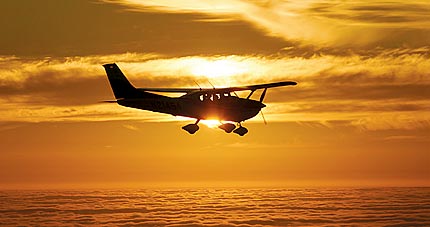A Garmin glass panel brings a fresh view for Cessna
 Cessna naysayers would complain that the company’s line of high-wing singles has changed little since its inception, save a continuing, but sometimes diminutive, evolution of enhancement and refinement. But at a recent gathering the company put on for its network of dealers, a sneak preview of the 2004 Skylane turned so many heads that more than 300 of the new C-182s, as well as Skyhawks and Stationairs, were sold—in a single day. Beginning in the second quarter of this year, Cessna will begin shipping its 230-hp four-seat singles with Garmin G1000 glass panels. From a distance, the 2004 Skylane isn’t particularly novel. It sports a blue, white and tan paint scheme for the new model year, but the silhouette is still classic Cessna. The finely finished leather interior is a holdover from an earlier year, and those with previous 182 experience will have little difficulty finding their way around inside. There are new LED lights in the cabin, giving the interior a jet-like feel.
Cessna naysayers would complain that the company’s line of high-wing singles has changed little since its inception, save a continuing, but sometimes diminutive, evolution of enhancement and refinement. But at a recent gathering the company put on for its network of dealers, a sneak preview of the 2004 Skylane turned so many heads that more than 300 of the new C-182s, as well as Skyhawks and Stationairs, were sold—in a single day. Beginning in the second quarter of this year, Cessna will begin shipping its 230-hp four-seat singles with Garmin G1000 glass panels. From a distance, the 2004 Skylane isn’t particularly novel. It sports a blue, white and tan paint scheme for the new model year, but the silhouette is still classic Cessna. The finely finished leather interior is a holdover from an earlier year, and those with previous 182 experience will have little difficulty finding their way around inside. There are new LED lights in the cabin, giving the interior a jet-like feel. But one look at the panel is all it takes to stop most pilots in their tracks. It’s a Garmin G1000 Integrated Cockpit System, which consists of two high-resolution display screens, a primary flight display (PFD) and multi-function display (MFD), providing flight, navigation, communication, terrain, traffic, weather and engine sensor data, all at the same time.
“Scanning the panel for all your information is practically a thing of the past,” says Cessna Flight Training Supervisor Kirby Ortega. “You don’t have to teach your eyes how to look all over the place for information. Now it’s all right there, right in front of you.”
One feature that caught Cessna’s corporate attention is the G1000’s Attitude Heading and Reference Systems (AHRS), which uses a system of algorithms to calculate all three axes of flight data. While all-glass panels rely on AHRS technologies, the G1000 is the only system that can initialize itself “on the move.” That might not sound like much at first blush, but the difference becomes more apparent should an AHRS system suffer a power interruption or otherwise hiccup. The G1000 can re-initialize itself in flight, while other systems require the pilot to land to get the system going again.
Also, the Garmin unit is the only system that’s “integrated.” For example, in the Cirrus SR22, Avidyne chose to design its FlightMax Entegra display screens to interface with two separate, stand-alone Garmin 430s mounted at the end of the pilot’s right hand. Garmin built all the navigation/communication/ surveillance radios to be self-contained within the G1000.
If the thought of having an electrically driven computer system replacing all your instruments has your attention, you’re not alone. “We don’t put all our eggs in one basket,” smiles Ortega. The new all-glass-paneled Skylane has what Cessna calls “an essential bus,” powered by a standby battery. The essential bus handles just what the name implies—the essentials, namely the PFD, primary flight sensors, engine monitoring and a single NAV/COM/GPS unit for at least 30 minutes. And for the truly apprehensive pilot, there’s a standard airspeed indicator, altimeter, mag compass and vacuum-driven attitude indicator as backup to the backup. “That way, you’ve always got the same basics you’ve always had,” Ortega adds.
Pilots without much experience “flying the glass” approach the new Skylane with understandable apprehension. Like any completely new system, the G1000 can seem a bit overwhelming at first.
“If you’ve been flying Garmin boxes for a while, you’re already way ahead in terms of the ‘knobology,’” Ortega says. “But even if you haven’t, it’s all very intuitive.” He recently shuttled a G1000-equipped Skylane from Wichita, Kan., to the California coast, much of the time watching over a student pilot at the controls. “After a while of flying along with the G1000, my student looked back down at the standard backup attitude indicator and said, ‘Holy smokes! I can’t fly with that thing anymore!’”
Because the new Garmin system is solid-state and lighter than “steam gauges,” G1000-equipped Skylanes can roll out of Wichita with 60-plus pounds of additional useful load. Though Cessna will continue to offer traditional avionics in all its singles, this top-of-the-line Garmin Integrated Cockpit System will be available first in both normally aspirated and turbocharged 182s. The company announced months ago that the Garmin glass panel also will be in the new Mustang jet and both normally aspirated and turbocharged 206 Stationairs, and is now sizing up plans to offer it in the 208 Caravan and perhaps even the entry-level 172 Skyhawk. The fact that Cessna sold out its entire production allotment of 2004 G1000-equipped Skylanes has left the company with an enviable problem: how to make even more.
SPECS: 2004 Cessna 182T Skylane N21452